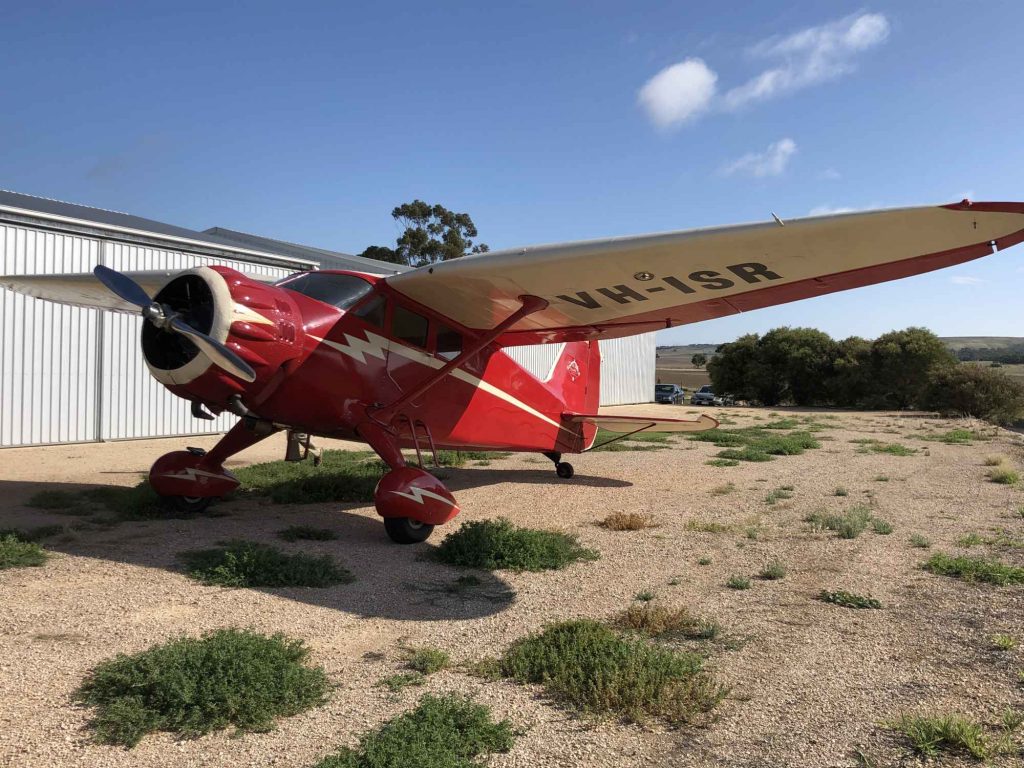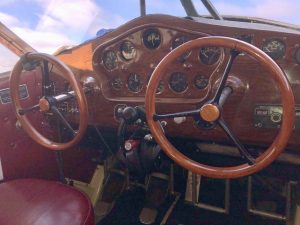Last meeting we enjoyed a very interesting and enthusiastic speaker in antique aircraft owner Tim Brownridge. Tim owns a DH82 Tiger Moth and a Stinson SR9E Reliant.
After the talk Tim invited me to fly with him in his Stinson a few days later, which I very quickly accepted.

The following are my personal observations of flying a machine such as this. I met Tim at his hangar at Callington and the first thing I noticed about the Stinson is its size. This is no regular GA aircraft. It is LARGE. At 42 foot wingspan, 1816kg all up weight and a 350HP Wright Whirlwind 7 cylinder radial engine (same as used on the Southern Cross), it has a commanding presence. It has a very elegant double taper fabric covered Gull wing which is something never seen on today’s aircraft. You have to climb a ladder to get into the cabin and once seated I estimate you are sitting nearly 9 feet above the ground.
The interior is gorgeous. Plush burgundy leather seats and side panels, a simulated woodgrain instrument panel and circular wooden steering wheels, very reminiscent of the luxury motor vehicles of the same era (1937). It can carry 5 persons all up, plus a large baggage compartment and 400 litres of fuel. Cruise is a surprisingly fast 115 kts at 70 litres per hour fuel consumption. This puts the endurance just short of 6 hours and with that payload makes it a very capable aircraft. Given this design is 85 years old makes it exceptional.


It is a fairly conventional cockpit layout with several interesting exceptions. Heel brakes are used which are not often seen these days. The elevator trim is a rotary handle in the cabin ceiling. Electric engine start is by a foot operated switch on the floor between the rudder pedals. Fuel quantity gauges are in each wing root up by your ears like a Piper Cub. The magneto switches and the electric flap switch are either side of the throttle and look very similar. Tim has confessed to accidentally turning off the engine when intending to lower the flaps! There is also a very nifty 24 hour analogue clock which takes a bit familiarity to interpret. And when it gets hot the cabin windows can be wound down, just like in a car!
Aircraft handling is entirely conventional albeit a little heavy as one would expect of an aircraft this size. I expected a wing drop during the stall, given the high taper of the wingtips. Yet it was very benign with only the tiniest of right wing drop. Visibility into turns is somewhat restricted given the high wing and the leading edge out in front of the pilot. It felt very solid and stable on approach at 70kts and touchdown was soft given the forgiving nature of the undercarriage design. The flare is commenced earlier than normal GA aircraft remembering how high you are seated above the ground. The only “gotcha” is the tailwheel. It is fully castoring and not lockable so you have to be on your rudder pedals quickly after landing to keep it straight, particularly in a crosswind.
Overall, a delightful experience which I feel very privileged to have had. Thanks Tim.
Last week we had about 15 turn up at Lyndon Wright’s workshop in McClaren Vale to view his dual projects of a Savannah LSA and a 1968 Porsche 911 restoration. Both were very nicely done, a testament to Lyndon’s engineering skills. Both projects are nearing completion but the Savannah has been taking a back seat for the last 18 months as Lyndon concentrates on getting the Porsche on the road first. He has a thing about older German technology so he has chosen to paint the Savannah to represent a WW2 era German observation plane.
At this months meeting we have as our speaker Captain Steve Burnard. Steve is recently retired from a long career with Dragonair (now known as Cathay Dragon) in Hong Kong. The bulk of his flying would have been from Hong Kong into various mainland Chinese airports which from experience I know were always interesting and challenging. He also operated into Kathmandu in Nepal which is renowned as one of the worlds more difficult jet airports. Come and hear his reminiscences entitled “Cathay Dragon Tales”.
Blue Skies,
Steve
Experience is the knowledge that enables you to recognise a mistake when you make it again.

